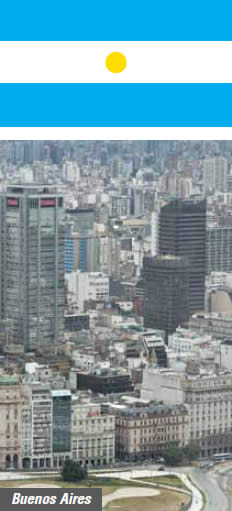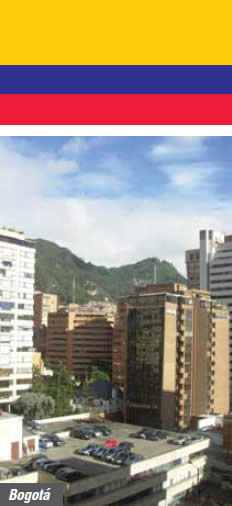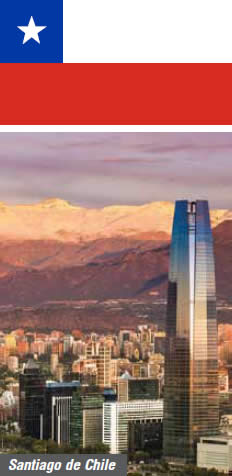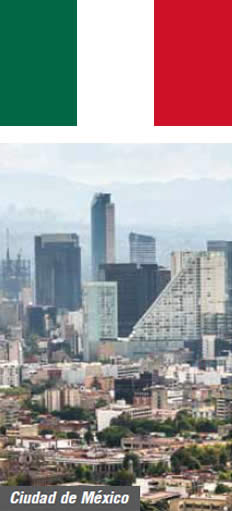
SPECIAL REPORT
Obtaining official information and facts and figures on Vertical Transportation in Latin America is always a complex task. Notwithstanding this, Revista del Ascensor carried out an investigation limited to the countries with the largest number of lifts installed and obtained this very up-to-date information to make its readers aware of information obtained from local sources in each country. The order of the countries is strictly alphabetical. The possibility of receiving information on other places remains open and if it is obtained it will be published in our next edition.
We want to thank all friendly Latin American businessmen who generously gave their time to prepare this report. To all of them, thank you very much.
1 How many elevators and escalators are installed in your country?
- What laws regulate the production, installation, maintenance and replacement of elevators?
- From which countries come the most elevators imported into your country?
- What is the subject of elevator parts production? What is the market share of regional producers?
- What is the average age of the elevators in the region?
- How many people work in elevator service and production? How many companies are there in the service and production of elevators?
- What is the average number of floors of residential apartments with elevators?
- What government agencies control the operation of elevators in the region?
- Is there a government program to replace old elevators in the area? How is financing provided?
ARGENTINA
1- In Argentina there are more than 300,000 elevator installations. It must be taken into account that a large part of the installations are located in the City of Buenos Aires (around 200,000), followed by Greater Buenos Aires (40,000) and the rest of the province of Buenos Aires (30,000). Together, Buenos Aires city and the province of Buenos Aires have 90% of the elevator installations in the entire country. While in the rest of the provinces, the cities with the largest number of elevators are: Córdoba (10,000 teams), Rosario (9,000), Mar del Plata (6,500), Plata (5,000) and Mendoza (3,500).
2- In Argentina, the ordinances and standards for the development, manufacture and installation of elevators are municipal, each municipality has its own standards and / or ordinances. There is a Building Code in the Autonomous City of Buenos Aires, which is used in much of the country, with modifications made by each municipality. The current Law No. 962 on Physical Accessibility for All is also being used. As a manufacturing and installation standard, the IRAM 3681 standard is being used.
3 – From Europe and Asia, mainly from China.
4 – Complete elevators and all kinds of components are manufactured. Only some kinds of traction machines, elements for electronic components and guides are imported
5 – Between 30 and 40 years old.
6 – It is estimated that between 15,000 and 20,000 people work in companies in the sector. And throughout the country there are estimated around 1500 companies among manufacturers, installers and conservators.
7 – The general average of the country is estimated between 6 to 10 floors, In Buenos Aires the average is estimated between 8 to 12 floors.
8 – DGFYCO is the dependency of the government of Buenos Aires city that, which among other things, is in charge of supervising the status of the elevators through scheduled visits allocated by lottery and also attending for complaints or emergency calls. In the other cities, the control varies according to the municipal government, but the main cities have good control of their elevators and there is also the mandatory monthly review carried out by conservative companies.
9- It doesn’t exist.
BOLIVIA
1- Currently, Bolivia has more than 2,800 elevators and 1,000 escalators.
2- Regulates Law 545 of 07/14/2014 (Ratifies Convention No. 167 “Convention on Safety and Health in Construction”, of the International Labor Organization – ILO).
3 – Spain, Argentina, China, Brazil.
4- In Bolivia, the mechanical parts of elevator manufacturing are developed a lot, not so electrical parts.
5- 10 to 25 years.
6- It is a difficult piece of information to quantify.
7- 6 floors, 6 stops.
8 – IBNORCA with the Bolivian standard.
9 – None.
BRAZIL
1 – It is estimated that there are approximately 500,000 elevators and 5,000 escalators. Only in the city of São Paulo there are 78.000 elevators registered in the City Prefecture.
2- The laws are municipal, that means that each municipality has its own legislation on the subject. But the ABNT (IRAM in Argentina) regulates projects and manufacturing only for Brazilians.
Standardization
Several other standards, in addition to the ABNT NBR 16083:2012, are regulated by the ABNTe and also contemplate the accessibility issue for people with disabilities or reduced mobility. Some standards are valid throughout the Mercosur area, being identified as ABNT NBR NM. Namely:
-ABNT NBR 16042: 2012 – Electric passenger lifts – Safety requirements for the construction and installation of machine room-less lifts
-ABNT NBR 15597: 2010 – Safety requirements for the construction and installation of lifts – Existing lifts – Requirements for improving the safety of electric passenger lifts and electric passenger and forklift lifts
-ABNT NBR 12892: 2009 – Single-family or use elevators for people with reduced mobility – Safety requirements for construction and installation
-ABNT NBR NM 313: 2007 – Lifts for passengers – Safety requirements for construction and installation – Particular requirements for accessibility of people, including people with disabilities
-ABNT NBR NM 267: 2002 – Hydraulic passenger elevators – Safety requirements for construction and installation
-ABNT NBR NM 196-DEZ: 1999 – Lifts for passengers and forklifts – Guides for cabins and counterweights – Profile T
-ABNT NBR NM 207: 1999 – Electric passenger lifts – Safety requirements for construction and installation
-ABNT NBR 14364: 1999 – Elevators and escalators – Elevator and escalator inspectors – Qualification
-ABNT NBR 10982: 1990 – Electric lifts – Operation and signaling devices – Standardization
-ABNT NBR 5665: 1983. Corrected version: 1987 – Traffic studies in elevators
-ABNT NBR 5666, which deals with terminology
3 – From Europe, mainly Spain and Italy.
4- Brazil has many national component manufacturing companies, in addition to having subsidiaries of many multinational companies.
5 – 30 years.
6- The companies are registered in each locality. Only in the city of São Paulo there are 132 legal companies in the service and production of elevators. There are still a number of companies not legalized.
7- Rio de Janeiro has an average between 8 and 12 floors; in São Paulo it is estimated between 10 and 16 floors. The person responding to this survey lives in a 34-story building, with 7 elevators (6 social and 1 service).
8- They are the prefectures (or municipal governments). In Brazil there are 3 executive levels that are: 1-federal (Presidency of the Republic); 2-state (state governor) and 3-municipal (prefectures).Each prefecture has its own regulation regarding the control of issues such as elevators.
9- It doesn’t exist. What does exist are municipal decrees that regulate the sector and the obligation of annual inspections.
COLOMBIA
1- Around 200,000 units among elevators, escalators, and elevator-type platforms.
2- In some cities of Colombia, it is regulated by the norm l Colombian Technical Standard NTC 5926-1 coordinated by the government of each city.
3- 79% of the equipment comes from China, 1% from Europe and 20% is locally manufactured.
4- Most of the spare parts are imported, the mechanical components are largely manufactured locally.
5- The average age of elevators in the region is 20 years old.
6- It is estimated that at the national level there is an average of 1000 people working in the trade. In recent years, a series of small companies, made up of technicians retired from different multinationals, have been born and are devoted to the maintenance of equipment. According to the registry of the Chamber of Commerce, there can be more than 500 companies.
7- Each city in Colombia has its own topography and culture that makes the construction of the building a little different from each other, but we could say that the average number of floors is between 12 and 15.
8- In particular the governments of each city through disaster prevention entities.
9- No, it doesn’t exist. It is clear that requirements for the certification of elevators are mandatory in some cities of Colombia. That makes the owners replace or modernize the elevator to comply with the said regulations.
CHILE
1- An estimated 45.000 elevators is the total park, although there is no exact registry of the equipment currently existing.
2- Law 20296 and 20290.
3- Most of the elevators are of Asian origin and to a lesser extent of European origin, there are practically no elevators of other origin.
4- In Chile, no components or parts of elevators are manufactured, except for rare exceptions that cannot be considered as a significant value.
5- The elevator installation boom occurred about 25 years ago. It is difficult to calculate because many of the old elevators have been updated with new technologies. We could say then that the average age is 25 to 30 years.
6- People employed in the trade exceeds 3,000 elevator workers, most of whom are maintenance workers and installers; components or complete elevators are not manufactured.
7- At present, some municipalities in their regulatory plans have limited the allowed height of real estate projects, which has rarefied the environment. An average of 10/12
Floors can be estimated.
8- Basically, the Municipality of each commune regulates and requires compliance with Law 20296-20290 for each building that has elevators.
9- Yes, there are government subsidies channeled through the MINVU, more specifically for housing improvement, which can be requested collectively by presenting a project for this purpose supported by the municipality.
ECUADOR
1- In Ecuador, we have around 15,000 elevators, national and imported, as well as escalators LOCATED in shopping centers in cities such as Quito, Guayaquil, Cuenca, among others.
2- In Ecuador, we do not have laws that regulate the production, installation, maintenance, and replacement of elevators, so we have many problems that indicate that there is no kind of support in certain productions.
3- In our country, most of the elevators are made by Hyundai, Mitsubishi, Fujitec, also Monarch controls, and Uruguayan cards.
4- In Ecuador, the issue of elevator parts production is very scarce. We only have what is mechanical parts such as pulleys, cabins.
5- The average age of elevators in the country exceeds 20 to 25 years and there are some that are much older than still operate with contactors.
6- In Ecuador, the number of people who work in the service and production of elevators is quite large, in the same way, the companies that work in the field would be around 100 registered in the Superintendence of companies. Similarly, there would be about 50 companies that operate without being registered.
7- The number of floors of residential buildings is varied, ranging from 8 floors to 16 floors high, which would be the average.
8- We do not have government agencies that control the operation in our country. For this reason, there are many shell companies that install and harm the customer with elevators that are second-use and practically do not install the elevator. That is our problem, the lack of control.
9- A replacement program for old elevators in the area does not exist.
MEXICO
1- More than 90,000.
2- NOM-053-SCFI-2000 Maintenance of elevators, escalators, ramps, and electromechanical sidewalks.
3- China, USA, Brazil, Spain, Japan, Korea.
4- There is almost no participation of regional producers, it has declined in the last 10 years.
5 – Over 20 years.
6 – There are more than 40 sales and installation companies and 80 devoted to maintenance.
7- Residential buildings have an average of 13 floors.
8- The Ministry of Economy and the Federal Consumer Prosecutor’s Office are the agencies responsible for monitoring compliance with official regulations.
9 – There is no government program for this purpose.
We want to thank all friendly Latin American businessmen who generously gave their time to prepare this report. To all of them, thank you very much.









